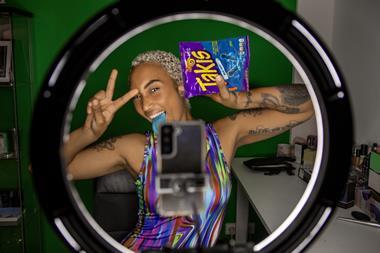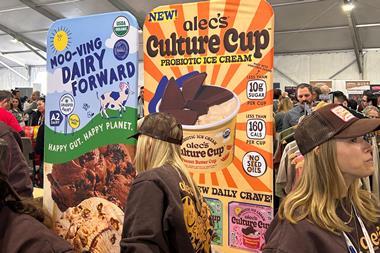A new smartphone app claims it will change the face of marketing. Vince Bamford downloaded Blippar to check out what it can do
When a bar of Cadbury chocolate arrived at The Grocer offices last week, along with instructions to download a new smartphone app, there was genuine amazement.
When the Cadbury countline was viewed through the iPhone’s screen it almost instantly activated video game Qwak Smack which, for the record, is played by tapping virtual ducks that seem to appear from beneath the bar of chocolate.
The Blippar app has been developed by a UK start-up of the same name that claims its utilisation of augmented reality (AR) the concept of adding another visual layer to a real-time view of the world can transform brand marketing.
Augmented reality isn’t a new concept. Back in 1984, Arnie sported an AR targeting system in The Terminator movie but it has only fairly recently made the leap from fiction to reality. Among the higher-profile uses of AR technology has been the iButterfly app that prompted Japanese iPhone users to wander the streets attempting to capture AR butterflies. Another is Layar, which will flag up points of interest when a smartphone user views the world through their device even pointing out nearby supermarkets when asked to.
But what sets Blippar apart from much of what has gone before is its stance as a strictly commercial application. CEO Ambarish Mitra waited until the Cadbury tie-up was in the bag and ready for public consumption before officially launching Blippar last week. And the business already has other major brands on board.
“Blippar is designed specifically for brands and advertisers,” says Mitra. “We are a specialist marketing platform that just happens to utilise world-leading technology.”
This technology includes image-recognition software that means Blippar can tell you are pointing your phone at a Cadbury countline and activate associated content.
Blippar isn’t alone in offering image recognition apps including Google Goggles and Layar Vision are also on the market but Mitra says his business’s focus on marketing sets Blippar apart.
And its potential extends beyond AR, he adds. “Image recognition can trigger anything a phone is capable of doing whether it’s a simple web link, a ‘call us now’, the nearest store location, or downloading a recipe to your phone. Augmented reality is just one of these applications, but it’s the most popular right now because of the ‘wow’ factor.”
Another USP, claims the company, is that Blippar works even when the user doesn’t have an internet connection. Content is regularly uploaded by the app and stored for instant access though an internet connection is required for some activities, such as accessing a brand’s website via the app, for example.
Blippar claims the ease of use and speed of its app make it a natural successor to QR codes as a way of accessing digital content on branded products. Certainly, the days of the QR code which must be scanned in and may then require manual activation were numbered before Blippar appeared, says Tom Ollerton, associate director at digital agency Skive.
“The arrival of the QR code promised seamless transition from the physical to the digital world, yet the reality of using QR codes is far from seamless,” he explains. “The process is clunky, the experience is awkward.”
However, talk of the death of QR codes may be a little premature, say other observers. Take-up of the technology has been limited in the UK although skim through a national newspaper and you’ll probably find at least one ad featuring a QR code but it has been more readily embraced in other territories. “Here in the UK we’re a little slow on the uptake of QR and image recognition technology, although we’re seeing a big move in Asia,” says Rick Evans, creative director of digital agency Untitled.
One big move was by Tesco’s Korean arm Home Plus, which transformed Seoul’s Hangangjin Station into a ‘virtual supermarket’ by pasting up posters of stocked shelves and encouraging commuters to ‘shop’ by scanning QR codes. If further trials work, the format could be rolled out across South Korea within two years.
This week, Ocado unveiled a similar trial at London’s One New Change shopping centre, although it is using standard barcodes rather than QR codes. It has filled a shop window with products and is urging shoppers to buy objects using the Ocado on the Go app.
Cadbury, meanwhile, says it might still find uses for QR codes, but concedes that the technology is limited. “Blippar offers a much richer experience,” says Sonia Carter, head of digital at Cadbury owner Kraft Foods. She adds that another big advantage Blippar has over QR and other printed on-pack marketing material is the much shorter lead time if changes need to be made to activity. “It would allow us to be much more reactive,” she says.
Blippar may also come as a relief to those designers who resent having to add an obtrusive QR code to their carefully-designed packaging or advertisement. However, some industry observers have suggested that the lack of any obvious visual indicator such as the presence of a QR code may hinder the adoption of Blippar, as consumers will have to be made aware a product has associated digital content.
Mitra concedes that a lot of consumer education will be required before Blippar content becomes part of a brand message and is expected by consumers. “Image-recognition AR needs to become more of an entrenched user behaviour,” he says. In the meantime, brands are likely to use more traditional methods, including advertising and on-pack messages, to encourage consumers to use digital content. In the case of Cadbury, it has spread the word about Spots vs Stripes-themed Qwak Smack through social media.
The lack of an obvious call to action will cease to be a problem if as some digital marketing experts predict the time will come when consumers expect every product to have a digital layer.
“There will be a tipping point where the general public will expect there to be a brand layer surrounding their product,” says Ollerton. “But until then brands will have to hold their hands through the process.”
What is Blippar?
- A smartphone app that can recognise a branded object and activate digital content associated with it
- Blippar has already released content for Cadbury and says it is developing partnerships with “famous” fmcg, travel, retail, entertainment and motoring brands
- It runs on iPhone and Android
- Blippar came about when the co-founders joked about making the image of the Queen on a £20 note speak
- CEO Ambarish Mitra has also created www.womeninfoline.com, the first Indian internet portal aimed at women, and mobile social network Stuck, which has more than 200,000 users



















No comments yet